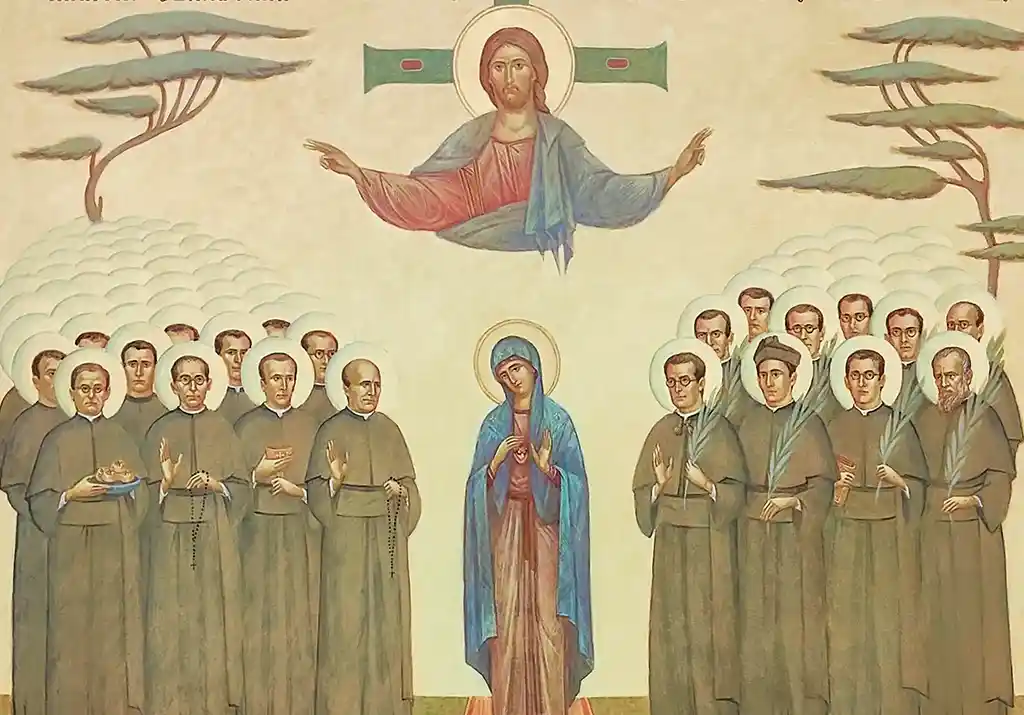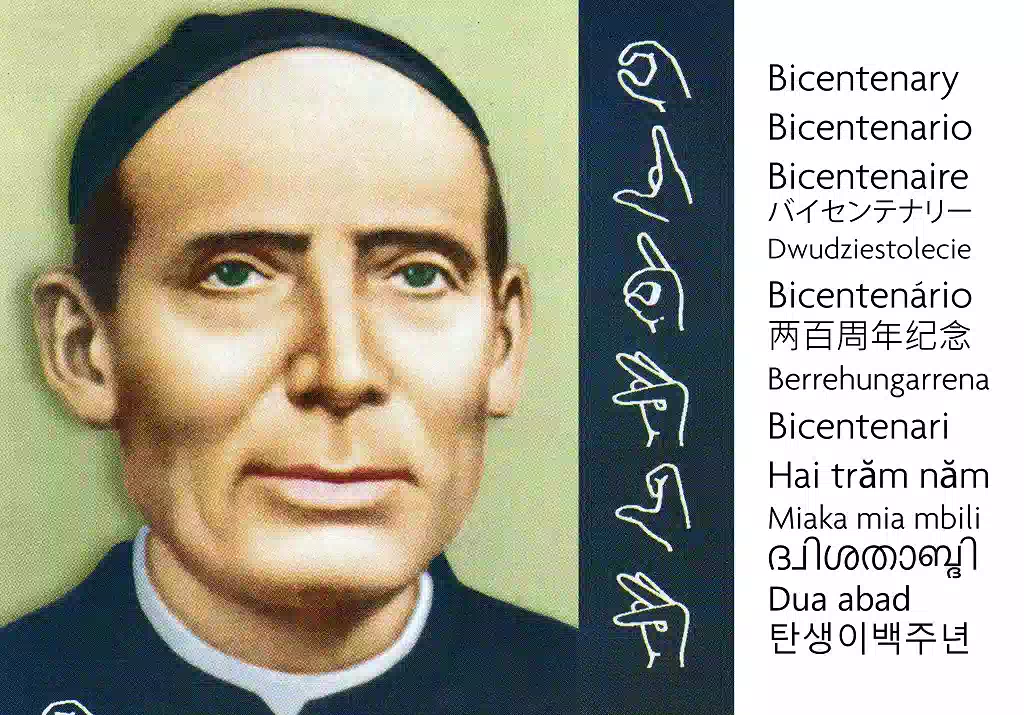On February 11, 1870, Pope Pius IX approved in perpetuity the Congregation of Missionaries and its Constitutions. It was the crowning achievement of a long and sometimes tortuous journey of discernment and deliberation. The Congregation, in dialogue with the Holy See, had been outlining and formulating its own identity. Fortunately, the entire journey took place during the lifetime of the Founder, who was a major player in the complex process.
The remote origin was in 1849, when Claret, before separating from his newly founded Missionaries to take charge of the archbishopric of Cuba, wrote them some “regulations or constitutions”. They did not have the format or the pretension of Constitutions of a religious institute, but were something much more spontaneous and free, oriented to live the “missionary state”; they did not contain the vows, but the apostolic virtues, headed by obedience (=availability to be sent). The Founder did not seek a solemn ecclesial endorsement, taking advantage of the presence of four bishops in Vic on the day of his episcopal consecration (which he did with the Constitutions of the Vedrunas Sisters), but the approval of his bishop, Msgr. Luciano Casadevall, was sufficient.
TOWARDS PONTIFICAL APPROVAL: A JOURNEY IN THREE STAGES.
1.- Stage one: up to the Decretum Laudis (1860)
On May 26, 1857, Claret returned from Cuba to Madrid to become a royal confessor. In the middle of June the superior of his Missionaries, Fr. Stephen Sala, presented himself in the capital to exchange impressions with him and to revise the normative text that, on his departure, he had left to them. The experience of six long years would have shown its greater or lesser functionality. The Congregation had grown moderately and its members wanted to be legally strengthened, through some kind of canonical and civil recognition, which required the printing of the Constitutions. The Founder, perhaps in conjunction with Fr. Sala, slightly revised the 1849 text and validated it with his signature on June 29: “We validate and sign these Regulations or Constitutions, that we have ordered and newly added” (EC I, p. 1363). On 8th September, in a solemn act of acceptance, they were signed by all the missionaries, who were 13 priests and 3 brothers. Before the end of 1857, they went to the press.
On 25 January 1858 Claret signed the request for his approval by the Pope (EC I, p. 1504f). Perhaps around the same dates he also began the procedures for its approval by the government of Madrid, which granted it on 9 July 1859; for this the Founder says: “I have made use of H.M., of the Minister and of trips to the Ministry” (EC I, 1623).
On September 1, 1858, the Constitutions were approved and recommended by the Bishop of Vic. And, on 3 April of the following year, perhaps better informed about the canonical procedures, Claret signed a second request to Rome (EC I, p. 1741), this time accompanied by that of the new Superior General, Fr José Xifré, and the approval by the diocesan bishop, Mgr Castañer. The Italian translation and other details of bureaucracy meant that the dossier was not presented to the now we know as the Congregation for Institutes of Consecrated Life and Societies of Apostolic Life until 27 February 1860. From Rome, they still requested a report on the number of houses, the number of priests, means of subsistence, etc. Claret sent it, with a new request for approval, on 30 September, supported by letters of recommendation from four other bishops (EC II, p. 35).
After examining everything, on October 19, 1860, Pius IX signed the Decretum Laudis, which the Congregation for Institutes of Consecrated Life and Societies of Apostolic Life sent a few days later to the Bishop of Vic and, through the nunciature, to Father Claret. The “Institute of Secular Missionary Priests” was widely praised and recommended, but the approval of its Constitutions was deferred until they were revised according to the Animadversions that would arrive on the attached sheet.
2.- Second stage: until the approval Ad decennium per modum experimenti (1865)
a. – Revision of the text by the First General Chapter (Grace, 1862)
It was held from July 7 to 14, under the presidency of the Founder. The Congregation had grown considerably, and had admitted seminarians; it was much more than an “institute of mission priests”. The chapter revised the Constitutions considerably and decided to add regulations for those in formation, as well as a formal act of incorporation into the Institute at the end of the probationary year, which would include an oath of permanence and a special consecration to God and Mary, and advised the taking of private vows.
The Founder himself, as soon as he returned to Madrid, wrote up what had been decided in the chapter: “Rules for Students… Consecration… Vows” (EC II, p. 510); on 28 July, while he was already in La Granja, he gave it in Segovia to Fr Serrat, who copied it and sent it to Fr Xifré in Vic. In December Claret also wrote rules for novices, aspirants and their master (EC II, p. 576). Several times the texts were retouched by the Founder himself and above all by Father Xifré, who in March 1863 sent to Rome the new constitutional text, already translated into Latin, with the approval of the Bishop of Vic, letters of commendation from other bishops, and with several complimentary documents. It was preceded by a petition of approval signed by Fr. Xifré and countersigned by his government, and another, normally signed by the Founder.
Both ask for “approval of the Constitutions with the additions and amendments made by the General Chapter and of the complementary appendix” (EC II, p. 616). Everything is addressed to Fr. Joseph Reig, a Mercedarian and former member of the mission house in Vic, who will from now on be the diligent and enthusiastic procurator of the Congregation of Missionaries before the Holy See. On April 20 he presented this entire dossier to the Pope, and in the following months, he will regularly visit the now Congregation for Institutes of Consecrated Life and Societies of Apostolic Life and inform Fr Xifré of how things are going.
b.- New revision by the General Government (1863-64)
But in September 1863 a serious setback arises. A Roman consultant discovers that the revision of the Constitutions has not taken into account the Animadversions drawn up in 1860, and the bishop of Vic is told that it could not go ahead. In fact, these Animadversions had been misplaced in the offices of the now Congregation for Institutes of Consecrated Life and Societies of Apostolic Life, and none of the Missionaries knew about them. They arrived in Vic on November 18, and Fr. Xifré, somewhat disconcerted, decided to call an extraordinary General Chapter for the new revision. But the Founder, less upset, advised him to arrange the texts in question according to the Constitutions of the Jesuits and the Redemptorists. Xifré and his Government, with the constant epistolary help of Fr. Reig, acted very quickly, so that by the beginning of 1864 the Constitutions were again revised and corrected, and on 3 February the solicitous procurator acknowledged receipt of everything. This time the request for approval, dated 11 January 1864, was not made by the Founder, but by Fathers Xifré, Clotet and Sala, as Superior, First Councilor and Secretary respectively. This request was supported by the Bishop of Vic and probably by the Nuncio Barylli who, at the end of January, asked the Founder for “brief news” of the Congregation, which he sent him almost immediately. This already consisted of “thirty-two priests, four students of Sacred Theology and eighteen lay brothers” (EC III, p. 447).
c. – New revision after the Second General Chapter (Gracia, 1864)
At the end of April 1864, in Rome, a number of animations to the text presented were formulated. These were studied in Vic and presented to the General Chapter, which took place from 3 to 6 July. The capitulars, somewhat uneasy about the Animadversions, had to listen to two meditations of the Founder on unconditional adhesion to the Holy See. Considering that the matter was in some points very technical, the Chapter delegated the new revision to the Founder, present there, who accepted to render this new service to his Missionaries. Although Father Xifré might have done almost all of them, always connected through letters to the Father Founder and Father Reig. On 30th January 1865, the Founder sent Pius IX the umpteenth request for the approval, now “definitive”, of the Constitutions (EC II, p. 855).
But in May, the now Congregation for Institutes of Consecrated Life and Societies of Apostolic Life informed Father Reig that the approval of the Constitutions must be preceded by that of the Institute. Such approval is requested by the Founder and the Superior General in an official letter signed on June 6. As a reason, they added: “so that the Congregation may make up in the best possible way for the lack of Orders of Religious” (EC II, p. 894). The Bishop of Vic also sent his request.
d.- Final touches, made in Rome in November 1865
At the end of October, the Founder travels to Rome because of the problem created by the royal approval of the Kingdom of Italy. He was accompanied by Fr. Xifré, with the express intention of expediting the matter of the Constitutions. His meetings with Fr. Reig will be important, and the three of them, as a team, following suggestions from Roman experts, will give the text its final form. Perhaps Fr. Xifré accompanied the Founder in one of his audiences with Pius IX, held on 6 and 23 November. The Pope must have given them hope of returning to Spain with the Constitutions approved, but a long illness of the secretary of the Congregation for Institutes of Consecrated Life and Societies of Apostolic Life prevented this. They left Rome on November 27, and on December 22, Pius IX signed the desired approval Ad decennium per modum experimenti, both for the Congregation and its Constitutions. Father Reig informed Father Xifré of this on the 23rd with his famous “Alleluia” letter, and the Founder, who had already been reinstated in Madrid, received the news on January 2nd, which “filled him with heavenly joy” (EC II, p. 969). By order of Fr. Xifré, foreseeing the time needed to translate them into Spanish and print them, the Constitutions would come into force on 1 April 1866, Easter Day.
Evidently, with the successive Animadversiones and retouches, the little code had been transformed from a “regulation for a small group of diocesan priests dedicated to the missions” into something very similar to a constitution of a “religious order”, only without vows and without the exemption that these normally enjoyed. The very text with which the Founder and the Superior General had asked for approval made it clear that their Congregation was not a religious order, but an institution which in some way could replace those which had disappeared through the laws of exclaustration.
3.- Third stage: until final approval (1870)
It was quick and easy. With the revolution of 1868, the Congregation had lost its juridical personality in Spain; but, after a little more than a year, it was established in countries on three continents: France, Algeria, and Chile. It went far beyond the diocesan level and escaped the Spanish laws of exclaustration. On the other hand, Father Xifré, in view of what had been approved in 1865, found no reason to postpone final approval for ten years. Finally, the presence of the Founder in Rome from April 1869, and that of the other Spanish bishops, from the autumn, on the occasion of the First Vatican Council, was a propitious moment for them to influence the Holy See in favor of what was intended.
In a letter to the Founder dated November 14, 1869 (EpPas III, p. 392ff), Father Xifré presented the draft of the request to the Holy See: definitive approval of the Congregation and its Constitutions and the obligation to take public vows, as a true religious order. For this, he hoped that Claret would employ “all his acknowledged zeal and courage“. With the Founder’s approval, Fr Xifré addressed the request to the Pope on December 1. And on the 16th Claret tells him that he is going around Roman offices and seeking the support of Spanish bishops and monsignors to achieve the desired goal (EC II, p. 1473ff).
On September 20, the Mercedarian Father José Reig had died, but from then on, the Bishop of Vic, Monsignor Luis Jordá, was appointed Procurator of the Missionaries. He, the Fr. Founder and his chaplain Fr. Lorenzo Puig will take turns in visiting the offices of the now Congregation for Institutes of Consecrated Life and Societies of Apostolic Life several times a week and informing themselves of the progress of the work. As a result of these efforts, on February 11, 1870, Pope Pius IX signed the definitive approval of the Constitutions, which had just been revised, and the recognition of the Congregation as an Institute of Public Vows, simple and perpetual.
Curiously, Fr. Claret is not informed and learns of the event during a visit to the chancery on 12 March. He immediately informs Fr. Xifré (EC II, p. 1455). The Decree of the now Congregation for Institutes of Consecrated Life and Societies of Apostolic Life was issued on 2 May and on 8 July Pius IX approved the Formula of Profession with the Profession of Vows. With this formula, all the members of the Congregation will be professed in the following months, and with it, the Claretians of the future will make their profession during a long century, until 1971.
Original Spanish Text: Severiano Blanco, CMF
Translated by: Louie Guades III, CMF









